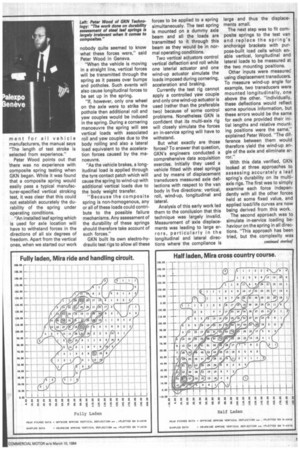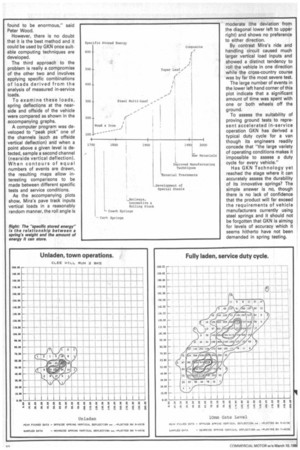GKN Technology describes how it had to develop new methods
Page 54

Page 55

Page 56

If you've noticed an error in this article please click here to report it so we can fix it.
of testing in order to assess the durability of its composite leaf springs
AS REPORTED in CM December 17 1983, and February 18 1984, GKN is in the vanguard of development of leaf springs made from composite materials and is set to begin volume production early in 1985.
Three weeks ago in Geneva at the first congress organised by the International Association for Vehicle Design, Peter Wood from GKN Technology's product evaluation division in Wolverhampton presented a paper which described how, in establishing durability testing procedures for the new springs, GKN's engineers had found that the conventional test methods used for steel components were unsatisfactory.
The paper began with a brief historical background to the development of leaf springs as vehicle suspension members. By relating the amount of energy each type of spring can store to its own weight, Peter Wood produced a measurement of specific stored energy and then showed how this had gradually increased from the days of the earliest wooden springs through steel multi-leaf, and tapered leaf to the latest composites.
He went on to describe how testing techniques to establish the fatigue life of springs have also improved and now include the application of wind-up loads (accelerating and/or braking loads) and combinations of longitudinal and vertical loads to check the integrity of eye end designs.
But the composite materials (undirectional glass fibres embedded in a matrix of epoxy resin) used by GKN gives a nonhomogenous structure. "This means that existing spring design and stressing rules no longer necessarily apply," he said. "The results of well-tried simple testing methods to establish spring fatigue lives can no longer be extrapolated to establish service durability."
Having designed its composite spring and developed a special manufacturing method, the question that GKN then had to answer was "How good will these springs be and how long will they survive?"
It began by referring to established procedures such as those recommended by the SAE manual but these were found too vague generally to be of much help. On the subject of the vertical stroking test for instance, which is a main require ment for all vehicle manufacturers, the manual says "The length of test stroke is selected from experience."
Peter Wood points out that there was no experience with composite spring testing when GKN began. While it was found that a composite spring would easily pass a typical manufacturer-specified vertical stroking test, it was clear that this could not establish accurately the durability of the spring under operating conditions.
"An installed leaf spring which is used for axle location will have to withstand forces in the directions of all six degrees of freedom. Apart from the vertical ones, when we started our work nobody quite seemed to know what these forces were," said Peter Wood in Geneva.
"When the vehicle is moving in a straight line, vertical forces will be transmitted through the spring as it passes over bumps and potholes. Such events will also cause longitudinal forces to be set up in the spring.
"If, however, only one wheel on the axle were to strike the pothole then additional roll and yaw couples would be induced in the spring. During a cornering manoeuvre the spring will see vertical loads with associated roll and yaw couples due to the body rolling and also a lateral load equivalent to the acceleration forces caused by the manoeuvre.
"As the vehicle brakes, a longitudinal load is applied through the tyre contact patch which will cause the spring to wind-up with additional vertical loads due to the body weight transfer.
"Because the composite spring is non-homogenous, any or all of these loads could contribute to the possible failure mechanisms. Any assessment of the durability of these springs should therefore take account of such forces."
GKN built its own electro-hydraulic test rigs to allow all these forces to be applied to a spring simultaneously. The test spring is mounted on a dummy axle beam and all the loads are transmitted to it through this beam as they would be in normal operating conditions.
Two vertical actuators control vertical deflection and roll while one laterial actuator and one wind-up actuator simulate the loads imposed during cornering, acceleration and braking.
Currently the test rig cannot apply a controlled yaw couple and only one wind-up actuator is used (rather than the preferable two) because of some control problems. Nonetheless GKN is confident that its multi-axis rig will closely simulate the forces an in-service spring will have to withstand.
But what exactly are those forces? To answer that question, GKN's engineers conducted a comprehensive data acquisition exercise. Initially they used a vehicle fitted with steel springs and by means of displacement transducers measured axle deflections with respect to the van body in five directions: vertical, roll, wind-up, longitudinal and lateral.
Analysis of this early work led them to the conclusion that this technique was largely invalid. Measurement of axle displacements was leading to large err o r s, particularly in the longitudinal and lateral directions where the compliance is
large and thus the displacements small.
The next step was to fit composite springs to the test van and replace the spring's anchorage brackets with purpose-built load cells which enable vertical, longitudinal and lateral loads to be measured at the two mounting positions.
Other inputs were measured using displacement transducers. To measure wind-up angle for example, two transducers were mounted longitudinally, one above the other. "individually, these deflections would reflect some spurious information, but these errors would be the same for each one provided their initial lengths and relative mounting positions were the same," explained Peter Wood. "The difference between them would therefore yield the wind-up angle of the axle and eliminate error."
With this data verified, GKN looked at three approaches to assessing accurately a leaf spring's durability on its multiaxis rigs. The first was to simply examine each force independently with all the other forces held at some fixed value, and applied load/life curves are now being derived from this work.
The second approach was to simulate in-service loading behaviour on the spring in all directions. "This approach has been tried, but the complexity was found to be enormous," said Peter Wood.
However, there is no doubt that it is the best method and it could be used by GKN once suitable computing techniques are developed.
The third approach to the problem is really a compromise of the other two and involves applying specific combinations of loads derived from the analysis of measured in-service loads.
To examine these loads, spring deflections at the nearside and offside of the vehicle were compared as shown in the accompanying graphs.
A computer program was developed to "peak pick" one of the channels (such as offside vertical deflection) and when a point above a given level is detected, sample a second channel (nearside vertical deflection). When contours of equal numbers of events are drawn, the resulting maps allow interesting comparisons to be made between different specific tests and service conditions.
As the accompanying plots show, Mira's pave track inputs vertical loads in a reasonably random manner, the roll angle is moderate (the deviation from the diagonal lower left to upper right) and shows no preference to either direction.
By contrast Mira's ride and handling circuit caused much larger vertical load inputs and showed a distinct tendency to roll the vehicle in one direction while the cross-country course was by far the most severe test.
The large number of events in the lower left hand corner of this plot indicate that a significant amount of time was spent with one or both wheels off the ground.
To assess the suitability of proving ground tests to represent accelerated in-service operation GKN has derived a typical duty cycle for a van though its engineers readily concede that "the large variety of operating conditions makes it impossible to assess a duty cycle for every vehicle."
Has GKN Technology yet reached the stage where it can accurately assess the durability of its innovative springs? The simple answer is no, though there is no lack of confidence that the product will far exceed the requirements of vehicle manufacturers currently using steel springs and it should not be forgotten that GKN is aiming for levels of accuracy which it seems hitherto have not been demanded in spring testing.




























































































